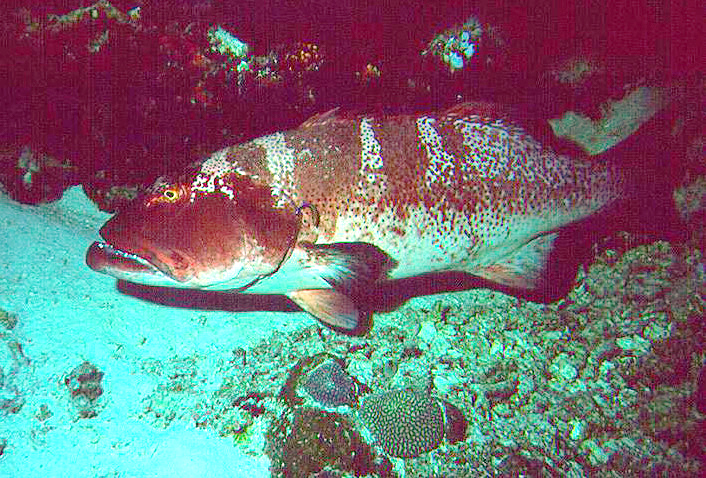Superregnum : Eukaryota
Cladus: Unikonta
Cladus: Opisthokonta
Cladus: Holozoa
Regnum: Animalia
Subregnum: Eumetazoa
Cladus: Bilateria
Cladus: Nephrozoa
Superphylum: Deuterostomia
Phylum: Chordata
Subphylum: Vertebrata
Infraphylum: Gnathostomata
Megaclassis: Osteichthyes
Superclassis/Classis: Actinopterygii
Classis/Subclassis: Actinopteri
Subclassis/Infraclassis: Neopterygii
Infraclassis: Teleostei
Megacohors: Osteoglossocephalai
Supercohors: Clupeocephala
Cohors: Euteleosteomorpha
Subcohors: Neoteleostei
Infracohors: Eurypterygia
Sectio: Ctenosquamata
Subsectio: Acanthomorphata
Divisio/Superordo: Acanthopterygii
Subdivisio: Percomorphaceae
Series: Eupercaria
Ordo: Perciformes
Subordo: Percoidei
Superfamilia: Percoidea
Familia: Serranidae
Subfamilia: Epinephelinae
Genus: Cephalopholis
Species: Cephalopholis leopardus
Vernacular names
čeština: Kanic leopardí
日本語: ミナミイソハタ
Cephalopholis leopardus, also known as the Leopard grouper or Leopard hind , is a species of marine ray-finned fish, a grouper from the subfamily Epinephelinae which is in the family Serranidae which also includes the anthias and sea basses. It is found in the Indo-Pacific.
Description
The Leopard grouper is a small to medium-sized fish which grows up to 24 cm.[3] The body is fusiform or spindle-shaped and compressed laterally. The caudal fin is rounded. The mouth is big and has a superior position. The body background coloration is light brown, reddish or light green-gray. On the top part of the body, blotches form marbling like pattern. The low part is spotted. The front snout is covered with small red or dark dots . The leopard grouper can easily be confused with Cephalopholis urodeta but it differs mainly from this latter by two dark blotches located on the top part of its caudal peduncle. The caudal fin is distinguished by two red to dark lines forming a "V" and another black line parallel to the top line of the "V".[4]
Distribution & habitat
It is widely distributed throughout the tropical waters of the Indian Ocean, Red Sea, Persian Gulf and South Africa excluded, to the central island of the Pacific Ocean.[5]
Like many of the groupers, Cephalopholis leopardus lives in rich clear waters close to coral or rocky reefs from the surface until 40 metres (130 ft) depth with an average depth range from 3 to 20 metres (66 ft).[6]
Feeding
Cephalopholis leopardus is carnivorous and its diet consists mainly in small fishes and crustaceans, it's an ambush predator.
Behavior
The leopard grouper is solitary, territorial, demersal and has a nocturnal and/or a diurnal activity which can be maximal at sunrise and/or at sunset.[7] It is protogynous hermaphrodite, which means the female can change sex to become male during its life.
References
Samoilys, M. (2018). "Cephalopholis leopardus". IUCN Red List of Threatened Species. 2018: e.T132737A100455324. doi:10.2305/IUCN.UK.2018-2.RLTS.T132737A100455324.en. Retrieved 20 November 2021.
Froese, Rainer; Pauly, Daniel (eds.) (2019). "Cephalopholis leopardus" in FishBase. December 2019 version.
http://eol.org/pages/204625/details#size
Lieske & Myers,Coral reef fishes,Princeton University Press, 2009, ISBN 9780691089959
"Cephalopholis leopardus, Leopard hind : Fisheries".
http://eol.org/pages/204625/details#habitat
Brulé & Déniel, ‘’ Expose synoptique des données biologiques sur le mérou rouge Epinephelus morio (valenciennes, 1828) du Golfe du Mexique’’, F.A.O., 1994,ISBN 9252034633
Retrieved from "http://en.wikipedia.org/"
All text is available under the terms of the GNU Free Documentation License


